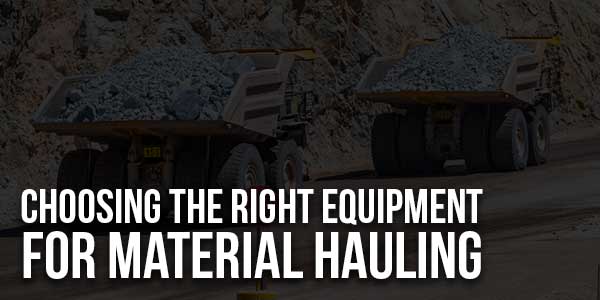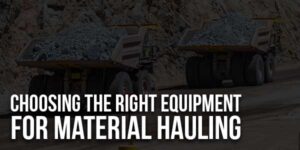
Material hauling is a crucial component across various industries, from construction and landscaping to logistics. Selecting the right equipment for this task can significantly impact efficiency, safety, and cost-effectiveness. This comprehensive guide will explore the essential aspects of choosing the best equipment for material hauling.
Table of Contents
Understanding the Types of Materials to Be Hauled:
Before diving into equipment selection, it is vital to understand the types of materials that will be transported. Each material type—be it sand, gravel, heavy machinery, or hazardous waste—has unique handling and transport requirements.
Lightweight Materials:
When dealing with lightweight materials, such as sand or soil, using equipment with high volume capacity becomes increasingly advantageous. This is because these materials can be bulky and require efficient transportation to ensure timely project completion. Dump trucks and flatbed trucks are ideal for such tasks, as they can carry larger loads and are designed for easy unloading.
Heavy Materials:
For heavier materials, such as concrete or large machinery, it’s crucial that the transport equipment adequately supports the weight, while also ensuring stability throughout the journey. Commonly used options for such tasks include flatbed trailers, which offer a spacious loading area that allows easy access and secure fastening of the load. Lowboys are another great option, designed specifically for transporting oversized loads, as they have a lower deck height that allows greater clearance. Heavy-duty trucks are also essential for transporting these materials, equipped with powerful engines and robust suspension systems to handle the demands of heavy hauling.
Hazardous Materials:
Transporting hazardous materials requires specialized equipment that meets strict safety regulations to protect both people and the environment. Tankers and containment vehicles are specifically designed to prevent leaks and spills, utilizing advanced engineering features such as double-walled tanks and pressure relief systems. These vehicles are equipped with monitoring systems that alert operators to potential issues during transit, ensuring safe transport.
Evaluating Different Hauling Equipment Options:
The market offers a range of hauling equipment, each designed to meet specific needs. Understanding these options is key to making an informed choice.
Dump Trucks:
Dump trucks are incredibly versatile vehicles, designed to transport loose materials such as sand, gravel, and dirt with impressive efficiency. Their robust construction allows them to handle heavy loads, making them essential for construction sites, landscaping projects, and various other industries. One of the standout features of dump trucks is their easy loading and unloading capabilities, facilitated by advanced hydraulic lift systems. These systems enable the truck bed to tilt, allowing materials to be dumped quickly and cleanly, which significantly streamlines operations and saves time on the job.
Flatbed Trucks:
Flatbed trucks are ideal for transporting larger, irregularly shaped loads that may not fit well in standard enclosed vehicles. Their open design provides easy access, making the loading and unloading of equipment and hard-to-pack items much more efficient. This versatility is especially beneficial for industries such as construction, landscaping, and shipping, where oversized materials like machinery, lumber, and heavy equipment need to be transported. Additionally, the flat surface allows secure strapping and stacking of various items, ensuring safe delivery to the destination.

Semi-Trailers:
Semi-trailers are an essential component of the logistics industry, providing high capacity for transporting bulky materials over long distances. Designed to be towed by trucks, these trailers often feature a flatbed or enclosed cargo space, making them ideal for a wide range of goods, including construction materials, machinery, and even refrigerated items. Their versatility allows them to be coupled with various tractor units, allowing them to accommodate different hauling needs, whether for local deliveries or cross-country freight. Additionally, semi-trailers can be customized with specialized features such as ramps, side doors, and weatherproofing to enhance their functionality for specific cargo types.
Lowboy Trailers:
Lowboy trailers are specifically designed for the safe and efficient transportation of heavy machinery and oversized loads. One of their key features is the low deck height, which provides enhanced stability during transit and allows for the transport of heavy loads without exceeding height restrictions imposed by bridges and overpasses. These trailers typically come equipped with ramps for easy loading and unloading, making them an essential tool for construction and industrial sectors where heavy equipment needs to be moved frequently and safely.
Factors to Consider When Selecting Equipment:
Choosing the right equipment involves considering various factors that align with your specific hauling needs.
Load Capacity:
The equipment’s load capacity should match or exceed the demands of the materials being transported to ensure optimal performance and safety. When selecting equipment, it’s crucial to consider the weight of the materials, their size and distribution, as uneven loads can further strain the machinery. Overloading can lead to serious consequences, including equipment damage, costly repairs, and potential safety hazards for operators and those nearby.
Distance and Terrain:
When planning to haul materials, it’s important to carefully consider both the distance and the type of terrain you’ll be navigating. For rough or uneven terrains, such as those found in construction sites or rural areas, equipment equipped with robust suspension and durable tyres is crucial.
Regulations and Compliance:
Ensure the chosen equipment meets industry regulations, particularly when it comes to transporting hazardous materials. Additionally, adhering to these regulations protects your organization from potential legal issues, fines, and liability claims, ensuring that operations run smoothly and responsibly. Taking the time to verify that all equipment meets the necessary standards is a vital step in fostering a culture of safety and accountability within the workplace.
Safety Considerations:
Safety is paramount in material hauling. Selecting equipment with built-in safety features can mitigate risks.
Stability and Control:
When selecting equipment, it’s crucial to choose models with advanced stability control systems. These features are designed to prevent tipping and accidents, particularly when navigating challenging terrains such as steep hills, rocky paths, or uneven surfaces.
Emergency Features:
Emergency brakes, lighting systems, and reflective surfaces are essential features that significantly enhance safety, especially during night or low-visibility conditions. Emergency brakes provide immediate stopping power in critical situations, reducing the risk of accidents. Meanwhile, advanced lighting systems, including headlights and taillights, improve visibility for drivers and pedestrians alike, ensuring that vehicles can be seen from a distance. Reflective surfaces, such as strips and decals, further contribute to safety by catching and reflecting light, making vehicles more visible in darkness or poor weather.
Operator Training:
Equip operators with proper training to handle specific equipment safely, ensuring they understand how to operate the machines and the safety protocols that must be followed. Familiarity with equipment features, such as controls, safety mechanisms, and limitations, is essential for preventing accidents and ensuring a smooth workflow. Regular training sessions should be conducted to refresh operators’ knowledge and keep them up to date with any changes in equipment or safety regulations.
Cost-Effectiveness:
While investing in quality equipment is important, it’s equally crucial to consider cost-effectiveness.
Purchase vs. Rental:
Determine whether purchasing or renting equipment is more economical. For short-term projects, renting might be the better option, while purchasing is more viable for long-term use.
Maintenance Costs:
Factor in maintenance and repair costs when selecting equipment. Regular maintenance ensures the longevity and reliability of hauling equipment.
Choosing the right equipment for material hauling is a multifaceted process that requires careful consideration of material types, equipment options, safety, and cost. By assessing these factors, businesses can enhance efficiency and safety while optimizing costs. Whether you’re in construction, landscaping, or logistics, having the right equipment tailored to your needs will ensure smooth and effective material transport.

 About the Author:
About the Author:















Be the first to write a comment.